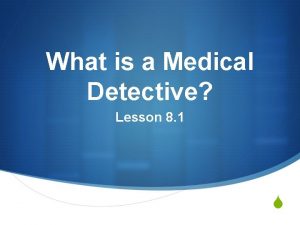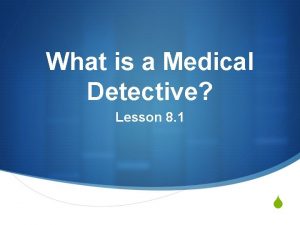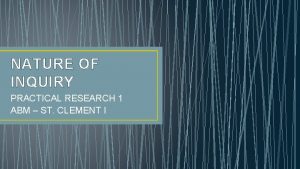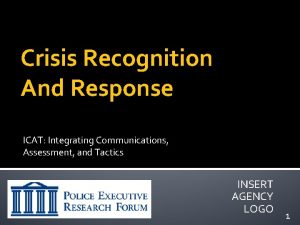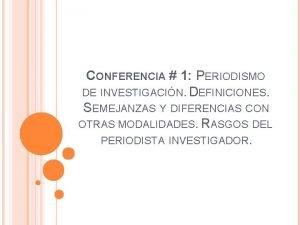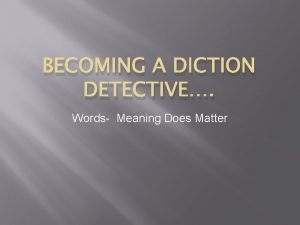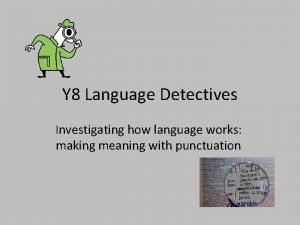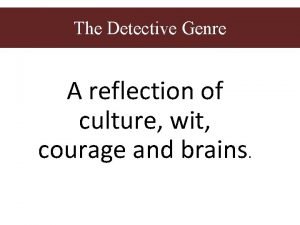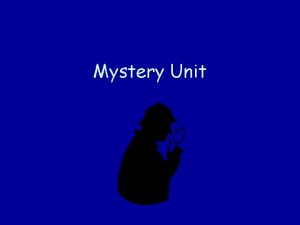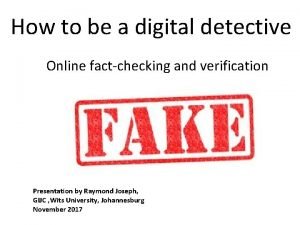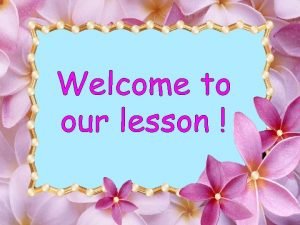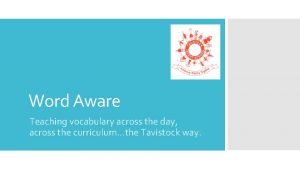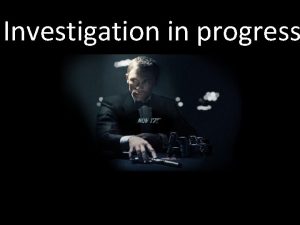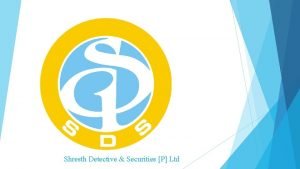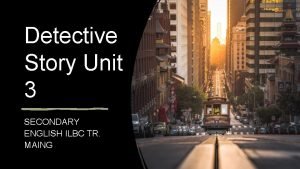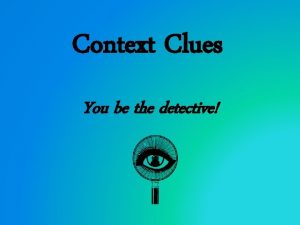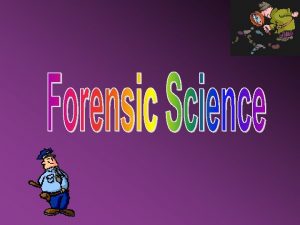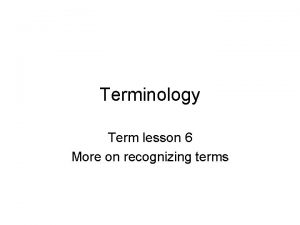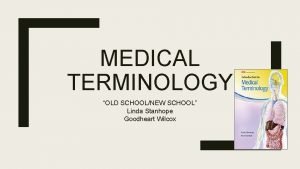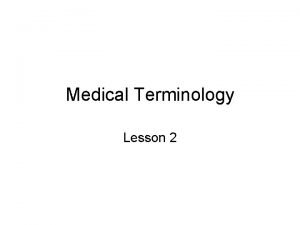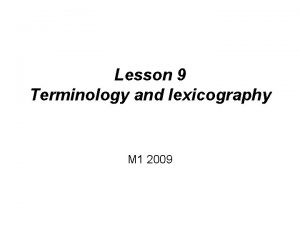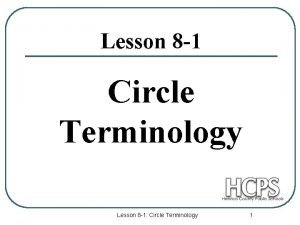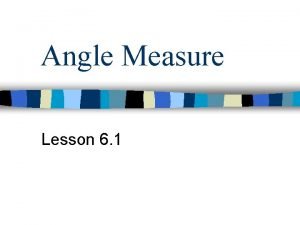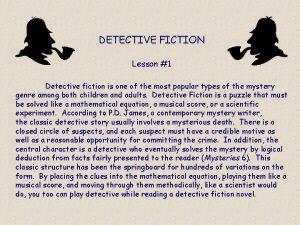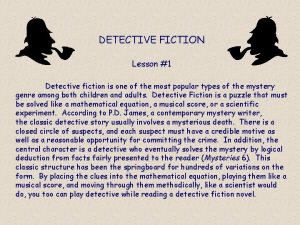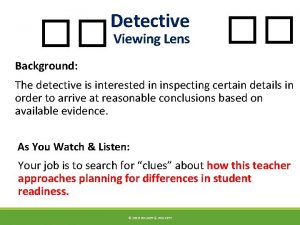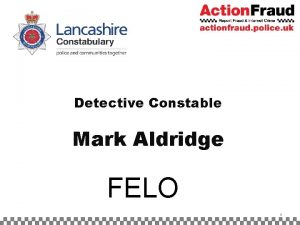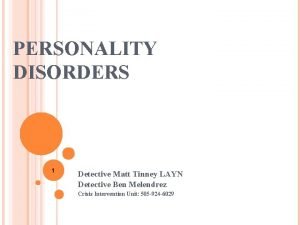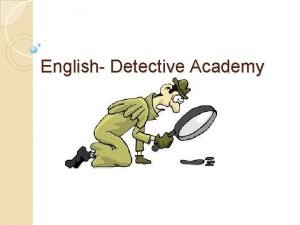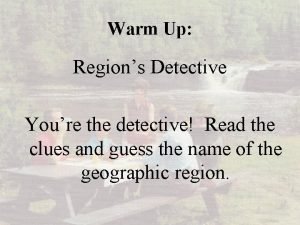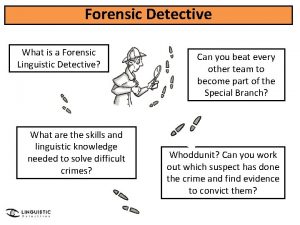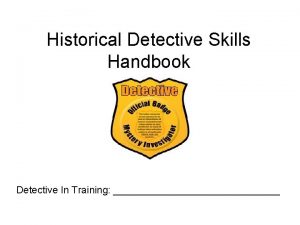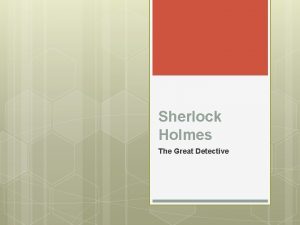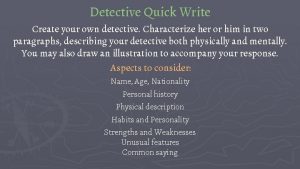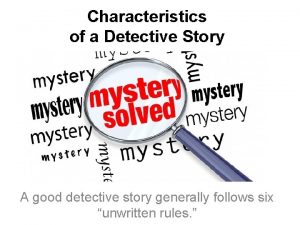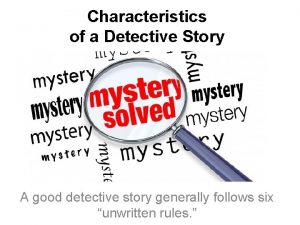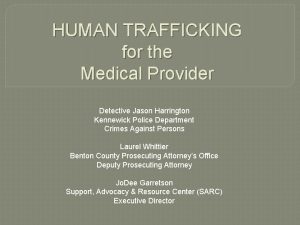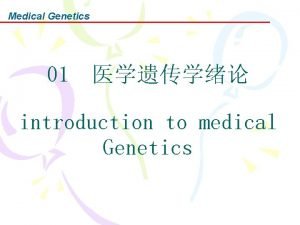What is a Medical Detective Lesson 8 1
























































- Slides: 56

What is a Medical Detective? Lesson 8. 1 S

Monday, Aug. 15 DO NOW: S Sign your syllabus. Take it home and have your parents to sign and write their email address. You may add your email address too if you want to receive newsletters from me about class each week. S You will need a composition notebook for this class!! S Get out your Agenda and fill in S 212 Syllabus due by Friday!! Thank you for sitting quietly while we begin

PLAN S Provide examples of how medical professionals contribute to the health and wellness of individuals. DO S Scavenger hunt for different biomedical science careers and their contribution to human health and wellness on Chromebooks S You will pick one career that you read and wrote about to tell someone in the class about.

Draw the following table on the front and back of the notebook paper given to you.

Scavenger Hunt S Use the website below to hunt for different Biomedical Science Careers. S This link can also be found on my Teacher Website. S http: //www. sciencebuddies. org/science-engineering- careers? From=Tab#health S Be sure to click on the different tabs at the top to view careers in different areas. S Choose one career for each letter of the alphabet. Write its name and the contribution of that career in the table you drew.

Tuesday, Aug. 16 DO NOW: S What is a medical detective? Thank you for getting started right away on your DO NOW (in the Tuesday box on your sheet).

What is a Medical Detective? S A Medical Detective is a person who uses his or her knowledge of science, technology, math, and communication to solve medical mysteries. S A variety of healthcare professionals act as medical detectives in identifying, treating, and preventing injury and illness in their patients. S These medical detectives are part of a larger group of professionals working in biomedical science. S Many careers participate in this work, including scientists, doctors, crime scene investigators, and biomedical engineers.

PLAN S Provide examples of how medical professionals contribute to the health and wellness of individuals. DO S We will complete our scavenger hunt for different biomedical science careers and their contribution to human health and wellness. S You will pick one career that you read and wrote about to tell someone in the class about.

Scavenger Hunt S Once you have completed a Biomedical Science Career for each letter of the alphabet, read back through your selections and choose one career that interests you the most. S Write, at the bottom (or on the back) of your table, the career you chose and why you chose that career. S Be able to give a description of that career and why you chose that career to someone in the

DO NOW WEDNESDAY th OCTOBER 19 S Write the following on your notebook paper. Leave some space between each one for writing answers. 1. Define homeostasis. 2. What is the hypothalamus? 3. How is a high temperature from a fever or infection different than a high temperature due to exercise or stress? 4. Why is a fever a good thing? 5. What temperature is a “good” fever?

PLAN S Measure vital signs including heart rate, blood pressure, and temperature. S Demonstrate use of technology as an important tool in the Biomedical Sciences. DO S Watch video and take notes S Read Vital Signs Temperature Introduction and highlight important information S Discuss and demonstrate how to use Go. Temp Probe and Logger Lite Software

1. Define homeostasis. 2. What is the hypothalamus? 3. How is a high temperature from a fever or infection different than a high temperature due to exercise or stress? 4. Why is a fever a good thing? 5. What temperature is a “good” fever?

Vital Signs: Temperature S Read the Introduction to the Lab. S On the back of your video questions and answers, write the information from the Introduction that is underlined. S On your lab sheet, make a hypothesis as instructed. S Read the Lab Procedures. S We will go through a demonstration when you are

DO NOW FRIDAY TH OCTOBER 20 : S AT YOUR TABLE, PICK S ONE PERSON TO GET A HALF CUP OF WATER S ONE PERSON TO GET A PIECE OF PAPER TOWEL S ONE PERSON TO GET OUT THEIR LAB SHEET S ONE PERSON TO GET THE GO!TEMP PROBE S ALL MATERIALS (EXCEPT YOUR LAB SHEET) ARE LOCATED ON THE COUNTER AT THE SIDE OF THE ROOM.

PLAN S Measure vital signs including heart rate, blood pressure, and temperature. S Demonstrate use of technology as an important tool in the Biomedical Sciences. DO S Conduct Temperature Lab in media center S Clean up when finished S Return to the classroom, copy data from lab partners, and work on Conclusion Questions

DO NOW MONDAY OCTOBER 24 th : 1. 2. 3. What is normal body temperature? Why do you think you and your teammates had different hand temperatures? Why was the maximum temperature of your hand NOT 98. 6°F (37°C)? Thank you for getting started right away on your DO NOW (in the Monday box on your sheet).

PLAN S Measure vital signs including heart rate, blood pressure, and temperature. S Demonstrate use of technology as an important tool in the Biomedical Sciences. DO S Finish and turn in Temperature Conclusion Questions. S Read Intro to Heart Rate and Blood Pressure Lab and take notes S Watch Cardiovascular System video S Color and draw arrows on Happy Heart sheet to show blood flow through the heart

Cardiovascular Video S http: //kidshealth. org/kid/closet/movies/CSmovie. html ? tracking=85031_A S As you watch the video, make notes on the path the blood takes as it flows through the heart.

DO NOW TUESDAY th OCTOBER 24 : S Which side of the heart receives oxygenated blood? S Which side of the heart receives deoxygenated blood? Thank you for getting started right away on your DO NOW (in the Tuesday box on your sheet).

PLAN S Measure vital signs including heart rate, blood pressure, and temperature. S Demonstrate use of technology as an important tool in the Biomedical Sciences. DO S Color and draw arrows on Happy Heart sheet to show blood flow through the heart S Demonstration of how to take heart rate and blood pressure S Conduct Vital Signs: Heart Rate and Blood Pressure Lab S Complete Conclusion Questions.

1 2 7 6 5 12 4 10 11 8 3 9

DO NOW TUESDAY th OCTOBER 24 : S Draw a flow chart to illustrate how blood flows through the heart. Thank you for getting started right away.

Blood Flow Through the Heart Tricuspid valve Bicuspid valve

PLAN S Measure vital signs including heart rate, blood pressure, and temperature. S Demonstrate use of technology as an important tool in the Biomedical Sciences. DO S Finish demonstration of how to take blood pressure S Conduct Vital Signs: Heart Rate and Blood Pressure Lab S Complete Conclusion Questions. S Turn in when complete.

DO NOW THURSDAY th OCTOBER 27 : 1. 2. What do you call high blood pressure? What factors can affect your blood pressure? Thank you for getting started right away on your DO NOW.

Heart Rate and Blood Pressure Lab S When you get to Procedure number 5 on your lab sheet, links to those websites (1 and 2) are posted on my teacher website, 212 Medical Detectives page. S You and the person at the table beside you may share a Chrome. Book to use those websites and answer the questions.

PLAN S Measure vital signs including heart rate, blood pressure, and temperature. S Explain the different ways a virus spreads through a population. S Describe the spread of a viral illness after inoculation (vaccination) is introduced. DO S Complete Conclusion Questions. S Turn in when complete. S Begin discussion of viruses and epidemics.

Epidemic: S Write the following in your biomedical journal. S Epidemic: an infectious disease that spreads rapidly and sickens a large number of people S Examples: avian flu, smallpox, and HIV

Avian Flu Outbreak of 1918 S Killed 30 -50 million people worldwide S That is more people than were killed in WWI. S Spread across the entire US in less than a month.



Viruses S Sub-microscopic particle that must infect living plant and animal cells to reproduce. S May spread through a population by S contact with contaminated surfaces S airborne droplets from coughing or sneezing by an infected individual S ingesting infected food or water S Prevention includes S Vaccines S Hand washing S Physical barriers (covering mouth and nose during cough or sneeze with arm or mask)

DO NOW THURSDAY th OCTOBER 27 : 1. 2. What do you call high blood pressure? What factors can affect your blood pressure? Thank you for getting started right away on your DO NOW.

PLAN S Explain the different ways a virus spreads through a population. S Describe the spread of a viral illness after inoculation (vaccination) is introduced. DO S Class activity investigating the spread of a virus and how vaccination (innoculation) affects the spread of the virus. S Answer Conclusion Questions

Chickenpox Outbreak S Caused by varicella zoster virus (VZV) S Highly contagious (spread from one person to another easily) S Spread by coming in contact with blister fluid or when an infect individual coughs or sneezes near you. S Infected individual is contagious and can spread the virus 1 -2 days before symptoms such as rash, fever, and body aches appear.

Chickenpox Outbreak S Draw this data table in your biomedical journal. Round Initial # Infected # Vaccinated 1 1 0 2 4 0 3 4 8 Final # Infected

Chickenpox Outbreak S Write and answer these conclusion questions in your biomedical journal. 1. What were some differences between Round 1 and 2. 3. 4. 5. 6. Round 2? Does Round 1 or 2 more closely simulate the spread of an epidemic? Explain why. How does Round 3 compare with Round 2? Predict what we would have seen if we had done a Round 4 with 14 people vaccinated. Describe ways a virus can spread through a population. Our school has a sudden, early outbreak of the flu. How can you protect yourself from contracting this viral

Friday, October Exit Slip: th 28 S Explain how vaccination (innoculation) affects the spread of a virus. Give evidence for your answer from our class

PLAN S Evaluate patient case files to diagnose the pathogen responsible for a patient’s mystery illness. S Describe the steps that a medical professional will take to diagnose and treat a patient. DO S Read Mystery Illness Introduction and take notes. S Food Safety Videos/Notes S Research 5 Least Wanted Pathogens (These are bacteria, not viruses. )

Food Safety: Clean

Food Safety: Separate

Food Safety: Cook

Food Safety: Chill

Research Least Wanted Pathogens S A link to the food safety. gov website link is on my 212 Medical Detectives website.

Monday, Aug. 22 DO NOW: S What were some common characteristics of the pathogens you researched on Friday? What were some differences? Thank you for quietly getting started right away on your DO NOW (in the Monday box on your sheet).

PLAN S Evaluate patient case files to diagnose the pathogen responsible for a patient’s mystery illness. S Describe the steps that a medical professional will take to diagnose and treat a patient. DO S We will go to the media center to let Mrs. Bunnell observe as we TRY to use the Internet to create flowcharts to help us diagnose a patient who has been infected with one of these pathogens. S If the internet cooperates, you will copy the flow chart you create on Lucidchart. com to page 18 of your journal. S If the Internet does not cooperate, we will create a flow chart on paper.

Tuesday, Aug. 23 DO NOW: According to this flowchart, what things should you check befor getting a new lamp?

Wednesday, Aug. 24 DO NOW: Draw a number out of the container. Write your number down in the Wednesday box on your DO NOW sheet.


Thursday, Aug. 25 DO NOW: 1. S 2. S 3. S 4. S 5. S Which pathogen (s) can be passed by deli meats and/or sandwiches? Listeria and Staphylococcus Which pathogen has a very sudden onset? Staphylococcus Which pathogen can be passed by raw poultry such as chicken? Campylobacter Raw eggs? Salmonella Raw hamburger? E. coli

DO NOW Friday August th 26 S Immediately get out a Chrome. Book and check over your presentation. S Share your presentation with me at donna. dyer 2@gmail. com S We will begin presentations at 9: 15. S 8 th Grade begins reporting to gym at 9: 45 so we have to have presentations completed before this time!

PLAN S Evaluate patient case files to diagnose the pathogen responsible for a patient’s mystery illness. S Describe the steps that a medical professional will take to diagnose and treat a patient. DO S Share presentations with me S Present Patient Diagnosis

Presentation of Patient Diagnosis S No more than 6 slides (one S Presentation should cover: S No more than 5 lines per S Patient history S Vital signs (Explain if these are slide with sources cited) slide S No more than 5 words per S line S Use 3 -5 sources S S S average, above, or below average) Probable pathogen (include an image and mode of infection) Is the pathogen contagious or infectious? How does the pathogen enter the body? (Ingested, inhaled, absorbed, etc. ) Common treatment plan

Biomedical Career Concept Map S Using the Biomedical Careers Website (link on my teacher website), create a Concept of one of the following Biomedical Careers. S Each student must do a different career. S In your Concept Map, be sure to include all information that is listed on your assignment sheet.

Biomedical Science Careers 1. Audiologist 9. Bioinformatics Scientist 2. Biomedical Engineer 10. Cytogenetic Technologist 3. Cardiovascular Technologist 11. Genetic Counselor 4. Certified Registered Nurse Anesthetist 12. Optometrist 5. 6. 7. 8. Cytotechnologist Hematologist Occupational Therapist Pathologist 13. Dietician 14. Endocrinologist 15. Epidemiologist 16. Health Educator 17. Nuclear Medicine Technologist

Setting up your Science Journal: 1. On the bottom right-hand corner of the first page, put a number 1. 2. On the back of that same page put a number 2. 3. Continue this until you have numbered to 30. 4. Turn back to page 1. 5. At the top, write: Table of Contents 1 -10 6. You are now ready to begin writing in your Biomedical Science Journal. 7. We will begin with our first item of the year on page
 What is a medical detective
What is a medical detective What is a medical detective
What is a medical detective The typology of detective fiction
The typology of detective fiction The no1 ladies' detective agency summary of each chapter
The no1 ladies' detective agency summary of each chapter Detective created by author sir arthur conan doyle
Detective created by author sir arthur conan doyle The detectives need more time to inquire
The detectives need more time to inquire Hard-boiled detective characteristics
Hard-boiled detective characteristics Detective draw
Detective draw Icat detective
Icat detective Semejanzas entre investigacion historia y periodistica
Semejanzas entre investigacion historia y periodistica What does diction mean
What does diction mean Language detective
Language detective Detective genre definition
Detective genre definition Word detective context clues
Word detective context clues Comparative and superlative of loud
Comparative and superlative of loud Elements of a mystery story
Elements of a mystery story Tin eye
Tin eye Detective noir
Detective noir Cartoon love
Cartoon love Word aware
Word aware Sis detective
Sis detective How to be a detective
How to be a detective Colombo detective
Colombo detective Sds security
Sds security Lumosity speed match
Lumosity speed match Examples of detective controls
Examples of detective controls Language detective
Language detective Twenty rules for writing detective stories
Twenty rules for writing detective stories Signal word in a sentence
Signal word in a sentence Context clues detective
Context clues detective Bloodstained optimizer vs expertise
Bloodstained optimizer vs expertise Detective story cartoon
Detective story cartoon California medical license for foreign medical graduates
California medical license for foreign medical graduates Gbmc medical records
Gbmc medical records Hepburn osteometric board
Hepburn osteometric board Torrance memorial outpatient lab
Torrance memorial outpatient lab Cartersville medical center medical records
Cartersville medical center medical records Lesson 6 medical terminology
Lesson 6 medical terminology Medical terminology lesson 12
Medical terminology lesson 12 Medical terminology lesson plans
Medical terminology lesson plans Medical terminology lesson 4
Medical terminology lesson 4 Medical terminology lesson 8
Medical terminology lesson 8 Algia medical term
Algia medical term Medical terminology lesson 7
Medical terminology lesson 7 Medical terminology lesson 9
Medical terminology lesson 9 Medical terminology lesson 3
Medical terminology lesson 3 Which term describes a torn, ragged wound?
Which term describes a torn, ragged wound? Lesson 12 medical terminology
Lesson 12 medical terminology Medical terminology lesson 4
Medical terminology lesson 4 Medical assistant lesson plan
Medical assistant lesson plan Polygons
Polygons Rotations and angle terminology
Rotations and angle terminology Lesson outline lesson 3 describing circuits answers
Lesson outline lesson 3 describing circuits answers Kind of fault
Kind of fault Lesson outline lesson 2 aquatic ecosystems answer key
Lesson outline lesson 2 aquatic ecosystems answer key Planning in micro teaching
Planning in micro teaching Ihi leadership alliance
Ihi leadership alliance
